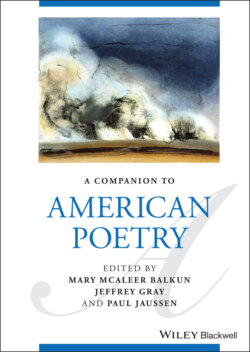Читать книгу A Companion to American Poetry - Группа авторов - Страница 47
REFERENCES LIST
Оглавление1 Abrams, M.H. (1965). Structure and style in the greater romantic lyric. In: From Sensibility to Romanticism: Essays Presented to Frederick A. Pottle, (ed. F.W. Hilles and H. Bloom), 527–560. New York: Oxford.
2 Armantrout, R. (1992). Feminist poetics and the meaning of clarity. In: Collected Prose, 38–48. San Diego: Singing Horse.
3 Bernstein, C. and Freschi, R. (2005). Charles Bernstein interview with romina freschi. Plebella 6: http://www.greeninteger.com/green_integer_review/issue_1/Charles-Bernstein-interview.htm (accessed 18 October 2021).
4 Blasing, M.K. (1995). Politics and Form in Postmodern Poetry: O’Hara, Bishop, Ashbery, and Merrill. Cambridge: Cambridge University Press.
5 Conrad, C.A. (2012). A Beautiful Marsupial Afternoon: New (Woma)tics. Seattle: Wave.
6 Conrad, C.A. (2014). Ecodeviance: (Soma)tics for the Future Wilderness. Seattle: Wave.
7 Culler, J.D. (1976). Structuralist Poetics: Structuralism, Linguistics, and the Study of Literature. United Kingdom: Cornell University Press.
8 Davidson, M. (1991). The poetics of everyday life. In: Poetics Journal Digital Archive, (eds. L. Hejinian and B. Watten), 342–345. Middletown: Wesleyan.
9 DuPlessis, R.B. (2001). Genders, Races, and Religious Cultures in Modern American Poetry, 1908–1934. Cambridge: Cambridge.
10 Eliot, T.S. (1953). The Three Voices of Poetry. In: On Poetry and Poets. United Kingdom: FSG.
11 Frye, N. (1951). The Archetypes of Literature. The Kenyon Review 13 (1): 92–110. https://www.jstor.org/stable/4333216. accessed 9 July 2020.
12 Hegel, G.W.F. (1975). Aesthetics: Lectures on Fine Art, 2 volumes. Oxford: Oxford.
13 Hejinian, L. (2000). The Language of Inquiry. Berkeley: University of California.
14 Hong, C.P. (2014). Delusions of Whiteness in the Avant-Garde. Lana Turner 7: http://www.lanaturnerjournal.com/7/delusions (accessed 18 october 2021).
15 Howe, S. (2012). Susan Howe, The Art of Poetry No. 97, interviewed by Maureen McLane. Paris.Review 203. https://www.theparisreview.org/interviews/6189/the-art-of-poetry-no-97-susan-howe
16 Howe, S. (2014). Spontaneous Particulars: The Telepathy of Archives. New York: New Directions.
17 Howe, S. (2015). The Birth-mark: Essay. United States: New Directions.
18 Jackson, V. and Prins, Y. (2014). The Lyric Theory Reader: A Critical Anthology. Baltimore: Johns Hopkins.
19 Lorde, A. (2020). Sister Outsider: Essays and Speeches. New York: Penguin Books.
20 Mill, J.S. (1860). Thoughts on poetry and its varieties. The Crayon 7: 93–97.
21 Perloff, M. (1973). Poetry Chronicle: 1970–71. Contemporary Literature 14 (1): pp. 97–131.
22 Perloff, M. (1981). The Poetics of Indeterminacy: Rimbaud to Cage. Princeton: Princeton.
23 Perloff, M. (1982). From Image to Action: The Return of Story in Postmodern Poetry. Contemporary Literature 23 (4): 411–427.
24 Philip, M.N. (2008a). Zong! Middletown: Wesleyan.
25 Philip, M.N. and Saunders, P. (2008b). Defending the Dead, Confronting the Archive: A Conversation with M. NourbeSe Philip. Small Axe 12 (2): 63–79.
26 Skillman, N. (2019). Lyric Reading Revisited: Passion, Address, and Form in. Citizen. American Literary History 31 (3): pp. 419–457.
27 Swenson, C. and St. John, D. (2009). American Hybrid: A Norton Anthology of New Poetry. New York: W.W. Norton.
28 White, G. (2014). Lyric Shame: The “Lyric” Subject of Contemporary American Poetry. Cambridge: Harvard.
29 Wright, J. and Bly, R. (2012). Collected Poems. Middletown: Wesleyan.
30 Yu, T. (2009). Race and the Avant-Garde: Experimental and Asian American Poetry since 1965. Stanford: Stanford.
